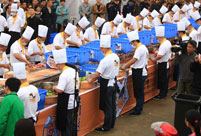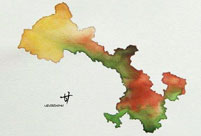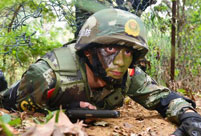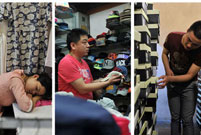 Avant-garde approach to graduation photos
Avant-garde approach to graduation photos
 Early PLA posters, signatures of an era
Early PLA posters, signatures of an era
 First Russian Street in Tianjin open to public
First Russian Street in Tianjin open to public
 Motorcycle stunt on the Bund
Motorcycle stunt on the Bund
 French Spiderman Alain Robert climbs up Galaxy Hotel in Macao
French Spiderman Alain Robert climbs up Galaxy Hotel in Macao
 Africans in Guangzhou
Africans in Guangzhou
 Pole dancer shows strength and beauty up in the air
Pole dancer shows strength and beauty up in the air
 College girls call for protection of ecological space on earth
College girls call for protection of ecological space on earth
 Top 10 celebrities driving auto brands
Top 10 celebrities driving auto brands
 10 low-carbon tips to save money
10 low-carbon tips to save money
U.S. researchers said Wednesday that it is possible to rebuild large amounts of muscles severely damaged in traumatic accidents or military wounds by implanted tissues of pig bladders.
Researchers from the University of Pittsburgh tested the experimental technique on five male patients, who had lost between 58 and 90 percent of limb muscle, and found that three of them had a 25 percent improvement in function.
"This new study is the first to show replacement of new functional muscle tissue in humans, and we're very excited by its potential," Stephen Badylak, senior investigator at the University of Pittsburgh.
"These are patients who can't walk anymore, can't get out of a car, can't get up and down from a chair, can't take steps without falling. Now we might have a way of helping them get better," Badylak said.
Large amounts of muscle can be lost as a result of trauma, such as a car accident, a sports injury, or even an explosive device. There is no treatment for such volumetric muscle loss and native muscle is unable to regenerate to that extent, to fully recovery function and tissue volume. Instead, scar tissue can form to fill the gap.
Stem cells have been shown to help damaged tissue regenerate, but in most cases, stem cells should be taken out, isolated and grown into the cell of choice, and then injected back into patients.
Badylak's team, however, used the extracellular matrix (ECM) from pig bladders to attract stem cells to the site of injury to promote regrowth of muscle.
According to the researchers, pig bladder ECM has been used for many years as the basis for medical products for hernia repair and treatment of skin ulcers. It is the biologic scaffold that remains left behind after cells have been removed.
After first showing the ECM method worked in mice with severely injured hind limbs, the researchers started a clinical trial involving five men, all at least six months removed from the time of injury, and for whom surgery and physical therapy had proved unsuccessful.
Three of the patients were in the military; two had thigh injuries from bombs while one had an exercise-induced calf injury. The other two patients were civilians with calf injuries from skiing accidents.
Before surgery, all patients completed a 12- to 16-week physical therapy program that focused specifically on their individual functional deficits. The program continued until their function and strength plateaued for a minimum of two weeks, with no signs of further improvement.
Then, the researchers surgically implanted a "quilt" of compressed ECM sheets designed to fill into their injury sites, and within 48 hours of the operation, the participants resumed physical therapy for up to 26 additional weeks.
The researchers found that three participants, including the two who had thigh injuries and one who had a calf injury, were stronger by 25 percent six months after the surgery and that biopsies and scans all indicated that muscle growth had occurred.
One thigh-injured patient improved on the "single hop test" by 1,820 percent, and the other had a 352 percent improvement in a chair lift test and a 417 percent improvement in the single-leg squat test.
Two other participants with calf injuries did not have such dramatic results, but both improved on at least one functional measure and said they felt better.
"This work represents an important step forward in our ability to repair tissues and improve function with materials derived from natural proteins. There will be more options to help our patients, " said study co-author Peter Rubin, chair of the department of plastic surgery at the University of Pittsburgh.
"We think it's remarkable that this approach was able to improve function among patients who were all well past the acute injury response phase and were not helped by the standard surgical procedures they had already had," Rubin added.
The findings were published in the U.S. journal Science Translational Medicine.
 The Western Qing Mausoleum
The Western Qing Mausoleum Overseas returnees strive for dreams in Beijing
Overseas returnees strive for dreams in Beijing Fried up: Chili pork bonanza in Central China
Fried up: Chili pork bonanza in Central China Hand-painted maps go viral online
Hand-painted maps go viral online 4th Beijing Int'l Film Festival ends
4th Beijing Int'l Film Festival ends Commando elite specializes in sign language
Commando elite specializes in sign language Man photoshops himself into girlfriend's childhood photos
Man photoshops himself into girlfriend's childhood photos Photo story: Stallholders at Beijing Zoo Wholesale Market
Photo story: Stallholders at Beijing Zoo Wholesale Market Artists on backstage
Artists on backstage 'African Street' in Guangzhou
'African Street' in Guangzhou Special operation members in comprehensive training
Special operation members in comprehensive training Cute Shaolin boy melts the hearts of millions
Cute Shaolin boy melts the hearts of millions Giant panda Sijia is back to happy life
Giant panda Sijia is back to happy life Richest Chinese of 2014: half from the mainland
Richest Chinese of 2014: half from the mainland Chengdu - laid-back lifestyle makes happiest city
Chengdu - laid-back lifestyle makes happiest cityDay|Week|Month